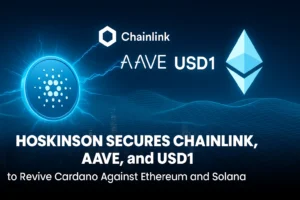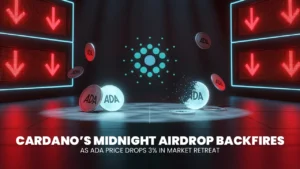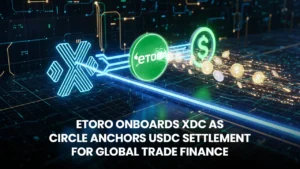TRON Sets New Records in USDT Transfers as Sui Activates Google Payment Agents

TRON’s network is humming, setting fresh highs in stablecoin movement and small-ticket transfers that look like real payments rather than speculation. In the same news cycle, Sui’s September update stack landed with a headline partnership around Google’s Agentic Payments Protocol, positioning Sui for AI-driven transactions with privacy-first rails.
- Rise of Stablecoins: TRON Leads the Payment Race
- Sui Switches on the Agent-Economy
- One Arc, Two Headlines: The DPoS Angle
- What Does the Data Say
- Side-By-Side Snapshot Of September Storylines
- Market Reaction And The Signal Beneath The Noise
- Community Pulse: Recent Tweets That Capture The Month
- Cost Curves And Product Choices
- Institutional Read: Compliance, Controls, And The Path To Scale
- Builder Lens: What To Ship Next
- Blended Take: Two Tracks, One Thesis
- Quick Metrics Board
- Conclusion
- Frequently Asked Questions About TRX and Sui Updates
- How big is TRX’s recent jump in activity?
- What exactly did Sui announce in September?
- Where does Delegated Proof of Stake fit into these updates?
- Did the market react to TRX’s metrics?
- Is Sui’s AP2 tie-in about price or product?
- Are these stories competing or complementary?
- Glossary of Key Terms
The two updates blend into a single story about Delegated Proof of Stake (DPoS) chains converting design choices into user behavior at scale. Low fees, fast finality, and predictable costs are not slogans on these networks; they are the mechanics that show up in the data and the product roadmaps.
ALSO READ: ARK Invest Returns to Alibaba After a 4-Year Hiatus as Europe AUM Crosses 1B Mark
Rise of Stablecoins: TRON Leads the Payment Race
Crypto Economy reports TRON has been one of 2025’s busiest blockchains, with a record day moving 62 billion TRX and daily USDT transfers that outrun last year’s levels by a wide margin. The kicker is the mix.
TRX handled over 181,000 transfers under 10 dollars in a single day and close to 1 million transfers between 100 and 1,000 dollars, far above the comparable Ethereum counts. That profile reads like remittances, allowances, tips, and checkout-size flows rather than whale moves. The article credits a zero-fee stablecoin policy as a key pull factor for retail activity.
Sui Switches on the Agent-Economy
Altcoin Buzz’s roundup puts Sui in the launch lane for Google’s Agentic Payments Protocol AP2, a standard that lets AI agents transact on behalf of users with privacy-first identity and programmable rules.
Mysten Labs, the team behind Sui, is framed as a core contributor rather than a spectator, with the update embedded in a broader September cadence that includes community events and a push toward SuiFest in Singapore on October 2 during Token2049.
The report also recaps the market context for SUI, noting a run from 0.76 dollars in early September 2024 to an all-time high near 5.35 dollars in early January, which set the backdrop for 2025 shipping velocity.
One Arc, Two Headlines: The DPoS Angle
Delegated Proof of Stake (DPoS) matters here because both chains are engineered for speed and cost-predictability under stake-weighted validator selection. TRX’s elected Super Representatives and Sui’s delegation model are different takes on the same core aim, which is to keep blocks fast, fees low, and performance headroom available for consumer-grade features.
The TRX update quantifies how a zero-fee stance on the dominant stablecoin can tilt behavior toward frequent, low-value transfers. The Sui update shows how a programmable, privacy-aware architecture can attract partnerships where agents spend for users under explicit rules and auditability. In both cases, DPoS is the operating system that makes those choices feasible.
What Does the Data Say
TRON’s numbers are the loud part. A record 62 billion TRX moved in one day, roughly 24 billion dollars in daily transfer value, and a long tail of small-payment activity that suggests day-to-day usage rather than one-off spikes.
TRX itself traded near 0.33 dollars after a brief 0.36 dollar print, and network activity remained elevated, underlining that usage and price do not always move in lockstep.
For Sui, the September summary is more about capability than counts, but the cadence is clear, with the AP2 tie-in and a visible event schedule that keeps the developer funnel warm.
Side-By-Side Snapshot Of September Storylines
| Dimension | TRON | Sui |
| Core September highlight | Surging USDT transfers, record throughput, retail-leaning transaction sizes | Launch partner for Google’s AP2, privacy-first programmable payments, event-heavy community push |
| Key metrics reported | Record day moving 62B TRX, 24B dollars daily transfer value, 181k sub 10 dollar transfers in a day, nearly 1M transfers in 100 to 1,000 dollar band | Market context includes SUI’s prior move from 0.76 dollars to 5.35 dollars ATH, September cadence focused on AP2 and SuiFest setup |
| DPoS takeaway | Delegated Proof of Stake aligns with low fees and fast settlement that fit payment-scale behavior | Delegated Proof of Stake underwrites predictable finality for agent-driven, rules-based spending and identity flows |
| Immediate watch items | Persistence of small-ticket flow, merchant-friendly tooling, and fee sustainability | AP2 pilots and demos, SuiFest announcements, and developer traction into Q4 |
Sources for metrics and milestones are linked to the two reports cited in this piece.
Market Reaction And The Signal Beneath The Noise
The TRON report notes TRX near 0.33 dollars after a local 0.36 dollars high, a modest pullback that does not dent the underlying usage story.
Price and volume often dominate headlines, yet the more durable signal is the composition of activity and the cost of conducting it. Sui’s roundup does not frame a specific price catalyst.
Instead, it emphasizes shipping, partnerships, and community momentum, which are the inputs that tend to precede sustained developer interest. Both updates are consistent with a DPoS playbook that sells speed and certainty to builders while keeping costs tight for end users.
ALSO READ: SunPerp Debuts on TRON, Challenges dYdX, GMX, and Hyperliquid with Cheaper Trades
Community Pulse: Recent Tweets That Capture The Month
Mysten Labs leaned into the AP2 story with a post that spelled out the agent-payment angle and emphasized privacy-first identity.
Sui is a launch partner for @Google’s new Agentic Payments Protocol (AP2) – a standard that lets AI agents transact on behalf of users.
Originally developed by Mysten Labs, @SuiNetwork brings fast, programmable payments and privacy-first identity to power the future of agentic… pic.twitter.com/YFfGfLUZvf
— MystenLabs.sui (@Mysten_Labs) September 16, 2025
The Sui community amplified on-the-ground presence with a Seoul clip that turned heads during Korean Blockchain Week.
Korea loves the @SuiNetwork 💧 robots 🤖 pic.twitter.com/wCSkfbOhG7
— David Ticzon | Sui💧Chief Degen (@DavidTiczon) September 23, 2025
On the TRON side, the day’s coverage focused on hard counts rather than fresh social media, but the message carried by the numbers is easy to read. Push stablecoin transfer costs to zero, keep confirmation times tight, and everyday payments start to live on-chain.
Cost Curves And Product Choices
For TRON, the economics of small transfers are the headline. Sub-10-dollar and 100-to-1,000-dollar bands are where checkout and peer payments live, and the network’s zero-fee stance for USDT directly addresses the friction that usually blocks those behaviors.
When gas is negligible and finality is fast, product teams can design around stablecoin units without building complex fee-shielding workarounds. That is the practical benefit of DPoS when optimized for payments.
For Sui, the cost story shows up as guardrails for new interfaces rather than raw per-transfer numbers. Agent spending requires caps, policies, and privacy by design. AP2 plus Sui’s object-centric model is presented as a path to programmable payments that respect user intent without leaking sensitive context.
Institutional Read: Compliance, Controls, And The Path To Scale
TRON’s usage profile overlaps with cross-border payments and merchant payouts, categories that sit near compliance chokepoints like redemption venues and on-ramps. The reported activity does not resolve regulatory questions, yet it does show that when costs are managed and throughput is available, users route around friction in search of speed.
Sui’s AP2 participation sketches a different bridge to institutions, one where auditability and consent are part of the stack. If agent-driven payments are to operate in regulated contexts, policy-bound spending and privacy-first identity will be required.
Builder Lens: What To Ship Next
On TRON, the data argues for checkout flows, tipping rails, gig-economy payouts, and loyalty programs that want instant settlement and dollar-denominated UX. Value accrues when the network becomes the default for moving USDT quickly and cheaply, which is the behavior that the latest metrics describe. On Sui, the next wave looks like agent-permissioning dashboards, escrow-like policies for spending, and SDKs that hide complexity for mainstream developers.
Blended Take: Two Tracks, One Thesis
Stablecoin usage and agentic payments sound like separate domains, yet they rhyme when you look through the cost and finality lens.
TRON shows what happens when you drive marginal cost toward zero for the most used settlement chip in crypto. Sui shows what happens when you offer programmable spending with privacy as a first-class constraint for software agents.
Quick Metrics Board
| Metric | TRON snapshot | Sui snapshot |
| Record day throughput | 62B TRX moved in one day | N.A. in the roundup, focus on AP2 capability |
| Daily transfer value | Around 24B dollars | N.A. in the roundup |
| Small-ticket activity | 181k transfers under 10 dollars in a day, nearly 1M in the 100 to 1,000 dollar band | Community engagement and AP2 launch partner status, momentum into SuiFest |
| Headline partnership | N.A. | Google AP2 launch partner, privacy-first programmable payments |
| Event cadence | Ongoing high network activity | SuiFest on October 2 during Token2049 |
All figures and events in this board are cited from the two source articles referenced in this piece. (Crypto Economy)
ALSO READ: PayPal’s PYUSD Lands on TRX Through LayerZero, Lifts Cross-Chain Reach to 1.3B
Conclusion
These storylines are more than isolated wins — they’re live demonstrations of how design choices translate into adoption. TRX’s zero-fee stablecoin stance has turned into real payment behavior, visible in the flood of sub-$10 and mid-range transactions that resemble remittances, allowances, and checkouts rather than speculative whale trades. Sui’s decision to embed itself in Google’s Agentic Payments Protocol shows the industry’s growing pivot toward programmable, privacy-first payments where AI agents act on behalf of users. Together, these moves underscore that Delegated Proof of Stake is not just a consensus model — it’s the operating system of consumer-grade crypto.
At the industry level, these trends highlight a shift away from speculation toward utility. Stablecoins and agent-based payments may sound like different lanes, but both point to the same horizon: blockchains as invisible infrastructure for everyday economic activity. By pushing costs down to near-zero and making finality predictable, DPoS networks like TRX and Sui are opening doors for merchants, cross-border workers, gig platforms, and even AI systems to operate seamlessly on-chain. This isn’t theory: the data, partnerships, and event calendars all suggest that the next wave of adoption will be measured in everyday transactions, not just market caps.
Both chains rely on Delegated Proof of Stake to deliver speed, budget certainty, and predictable finality, and both are turning those properties into observable usage and partnerships. If these trends persist, the near-term winners will be the teams that build simple, compliant, and high-frequency experiences on top of DPoS rails.
Frequently Asked Questions About TRX and Sui Updates
How big is TRX’s recent jump in activity?
The report highlights a record day moving 62B TRX and strong daily USDT transfer value near 24B dollars, with a large share of small-ticket transactions under 10 dollars and within the 100 to 1,000 dollar band.
What exactly did Sui announce in September?
The company is a launch partner for Google’s Agentic Payments Protocol, which aims to let AI agents transact for users with privacy-first identity and programmable rules, alongside community events culminating in SuiFest on October 2.
Where does Delegated Proof of Stake fit into these updates?
Both cryptos use DPoS to achieve fast blocks and predictable costs, a fit for payments and agent-driven transactions that need speed, reliability, and budgetable fees at a consumer scale.
Did the market react to TRX’s metrics?
The article notes TRX near 0.33 dollars after touching 0.36 dollars, a modest move that does not change the underlying usage signal.
Is Sui’s AP2 tie-in about price or product?
The roundup emphasizes product and ecosystem progress rather than price, with attention on agent payments, privacy, and developer momentum heading into SuiFest.
Are these stories competing or complementary?
They are complementary. TRX is optimizing for high-frequency stablecoin payments. Sui is optimizing for agentic, policy-bound spending. Both leverage DPoS to deliver speed and certainty.
Glossary of Key Terms
- Delegated Proof of Stake (DPoS) – A consensus model where token holders delegate stake to validators or elect block producers, optimizing for speed and predictable fees.
- Validator – A node responsible for producing blocks and confirming transactions under DPoS rules.
- Finality – The point at which a blockchain transaction is considered irreversible.
- Stablecoin – A crypto token pegged to a stable asset, usually the U.S. dollar, used for payments and settlements.
- Throughput – The number of transactions a network can process per second or per day.
- Gas fee – The cost paid to process a blockchain transaction, often variable depending on network demand.
- USDT (Tether) – The most widely used stablecoin, pegged to 1 U.S. dollar, deployed across multiple blockchains.
- AP2 (Agentic Payments Protocol) – A Google-led standard enabling AI agents to execute programmable on-chain payments with privacy safeguards.
- Small-ticket transfer – A low-value payment, such as under 10 dollars, often representing retail or peer-to-peer transactions.
- Remittance – A cross-border money transfer, typically small in value, where speed and low fees are critical.




